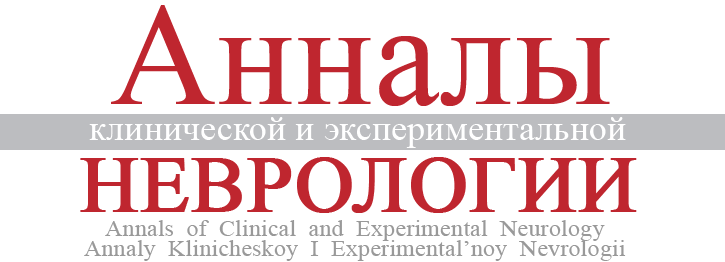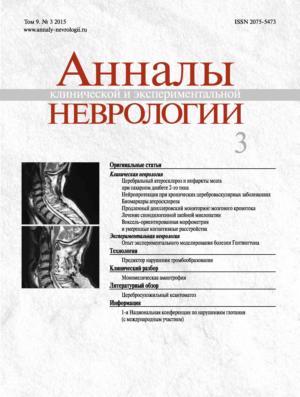Значение воксель-ориентированной морфометрии в изучении умеренных когнитивных расстройств
- Авторы: Дамулина A.И.1, Коновалов Р.Н.1, Кадыков A.С.1
-
Учреждения:
- ФГБНУ «Научный центр неврологии»
- Выпуск: Том 9, № 3 (2015)
- Страницы: 42-48
- Раздел: Технологии
- Дата подачи: 01.02.2017
- Дата публикации: 09.02.2017
- URL: https://annaly-nevrologii.com/journal/pathID/article/view/138
- DOI: https://doi.org/10.17816/psaic138
- ID: 138
Цитировать
Полный текст
Аннотация
Когнитивные нарушения являются важной медико-социальной проблемой, связанной с высокой распространенностью этой патологии в популяции. В течение 5 лет после постановки диагноза умеренных когнитивных расстройств (УКР) у 46% больных развивается деменция. Актуальным методом нейровизуализации, хорошо зарекомендовавшим себя в изучении деменции, является воксель-ориентированная морфометрия (ВОМ). Проведение ВОМ в сочетании с нейропсихологическим исследованием пациентов позволяет уже на начальном этапе заболевания уточнить генез УКР и прогнозировать дальнейшее развитие заболевания.
Об авторах
A. И. Дамулина
ФГБНУ «Научный центр неврологии»
Автор, ответственный за переписку.
Email: damulinaanna@gmail.com
Россия, Москва
Родион Николаевич Коновалов
ФГБНУ «Научный центр неврологии»
Email: damulinaanna@gmail.com
ORCID iD: 0000-0001-5539-245X
к.м.н., с.н.с. отд. лучевой диагностики
Россия, 125367, Москва, Волоколамское шоссе, д. 80A. С. Кадыков
ФГБНУ «Научный центр неврологии»
Email: damulinaanna@gmail.com
Россия, Москва
Список литературы
- Блейхер В.М., Крук И.В., Боков. С.Н. Клиническая патопсихология: руководство для врачей и клинических психологов. М.: Изд-во Московского психолого-социального института, 2006. 624 с.
- Дамулин И.В. Когнитивные расстройства. Некоторые вопросы клиники, диагностики, лечения. М., 2012. 19 с.
- Дамулина А.И., Кадыков А.С. Когнитивные нарушения при хронической ишемии головного мозга. Фарматека. 2014; 10: 63–69.
- Деменция: приоритет общественного здравоохранения. ВОЗ;Международная организация по проблемам болезни Альцгеймера. 2013: 2–8.
- Колесниченко Ю.А., Машин В.В., Иллариошкин С.Н. и др. Воксел-ориентированная морфометрия: новый метод оценки локальных вторичных атрофических изменений головного мозга. Анн. клинич. и эксперим. неврологии. 2007; 1 (4): 36.
- Леонтьев А. Развитие памяти. Москва: Государственное медико-педагогическое издательство, 1931: 82–99.
- Полунина А.Г., Брюн Е.А. Эпизодическая память: неврологические и нейромедиаторные механизмы. Анн. клинич. и эксперим. неврологии. 2012; 6 (3): 53–61.
- Шахпаронова Н.В., Кашина Е.М., Кадыков А.С. Когнитивные нарушения у постинсультных больных с глубокой локализацией полушарного очага. Анн. клинич. и эксперим. неврологии. 2010;4 (3): 4–10.
- Alberta M., De Koskyb S., Dicksond D. et al. The diagnosis of mild cognitive impairment due to Alzheimer’s disease: Recommendations from the National Institute on Aging- Alzheimer’s Association workgroups on diagnostic guidelines for Alzheimer’s disease. Alzheimers Dement .2011 May;7 (3): 270–279.
- de Leon M., Golomb J., Convit A. et al. Measurement of medial temporal lobe atrophy in diagnosis of Alzheimer’s disease. Lancet 1993 Jan 9; 341 (8837): 125–126.
- Fernando M., Ince P. Vascular pathologies and cognition in a population-based cohort of elderly people. J Neurol Sci 2004; 226 (1–20):13–17.
- Frisoni G., Testa C., Zorzan A. et al. Detection of grey matter loss in mild Alzheimer’s disease with voxel based morphometry. J Neurol Neurosurg Psychiatry. 2002 Dec; 73 (6): 657–664.
- Horinek D., Varjassyova A., Hort J. Magnetic resonance analysis of amygdalaar volume in Alzheimer’s disease. Curr Opin Psychiatry. 2007 May; 20 (3): 273–277.http://www.dsm5.org
- Jellinger K. The enigma of mixed dementia. Alzheimer Dement 2007; 3 (1): 40–53.
- Jelinger K., Attems J. Neuropathological evolution of mixed dementia. J NeurolSci 2007; 257 (1–2): 80–87.
- Karas G., Scheltens P., Rombouts S. et al. Global and local gray matter loss in mild cognitive impairment and Alzheimer’s disease. Neuroimage. 2004 Oct; 23 (2): 708–716.
- Kordower J., Chu Y., Stebbins G. et al. Loss and atrophy of layer II entorhinal cortex neurons in elderly people with mild cognitive impairment. Ann Neurol 2001 Feb; 49 (2): 202–213.
- Li C., Du H., Zheng J. et al. A voxel-based morphometric analysis
- of cerebral gray matter in subcortical ischemic vascular dementia patients and normal aged controls. Int J Med Sci. 2011; 8 (6): 482–486.
- Lim A., Tsuang D., Kukull W. et al. Clinico-neuropathological correlation of Alzheimer’s disease in a community-based case series. J Am GeriatrSoc 1999; 47 (5): 564–569.
- McKhann G., Drachman D., Folstein M. et al. Clinical diagnosis of Alzheimer’s disease: Report of the NINCDS-ADRDA Work Group under the auspices of Department of Health and Human Services Task Force on Alzheimer’s Disease. Neurology. 1984; 34: 939–944.
- Nasreddine Z., Phillips N., Bédirian V. et al. The Montreal Cognitive Assessment, MoCA: a brief screening tool for mild cognitive impairment. J Am Geriatr Soc. 2005; 53 (4): 695–699.
- Nyenhuis D., Gorelick P.B.: Vascular dementia: a contemporary review of epidemiology, diagnosis, prevention, and treatment. J of the American Geriatrics Society 1998, 46:1437–1448.
- Pennanen C., Kivipelto M., Tuomainen S. Hippocampus and entorhinal cortex in mild cognitive impairment and early AD. Neurobiol Aging. 2004 Mar; 25 (3): 303–310.
- Petersen R.C., Smith G.E., Waring S.C. et al. Mild cognitive impairment: clinical characterization and outcome. Archives of neurology. 1999; 56 (3): 303–308.
- Pihlajamäki M., Jauhiainen A., Soininen H. Structural and functional MRI in mild cognitive impairment. Curr Alzheimer Res, 2009 Apr; 6 (2):179–185.
- Quinque E., Arélin K., Dukart J. Identifying the neural correlates of executive functions in early cerebral microangiopathy: a combined VBM and DTI study. J Cereb Blood Flow Metab. 2012 Oct; 32 (10):1869–1878.
- Rockwood K., Song X., MacKnight C. et al. A global clinical measure of fitness and frailty in elderly people. CMAJ 2005; 173: 489–495.
- Rockwood K., Wentzel C., Hachinski V. et al. Prevalence and outcomes of vascular cognitive impairment. Vascular cognitive impairment investigators of the Canadian study of health and aging. Neurology. 2000; 54: 447–4451.
- Rosen W., Mohs R., Davis K. A new rating scale for Alzheimer’s disease. Am J Psychiatry. 1984; 141: 1356–1364.
- Scheltens P., Leys D., Barkhof F. Atrophy of medial temporal lobes on MRI in “probable” Alzheimer’s disease and normal ageing: diagnostic value and neuropsychological correlates. J NeurolNeurosurg Psychiatry. 1992 Oct; 55 (10): 967–972.
- Schmidt-Wilcke T., Poljansky S., Hierlmeier S. et al. Memory performance correlates with grey matter density in the ento-/perirhinal cortex and posterior hippocampus in patients with mild cognitive impairment and healthy controls – a voxel based morphometry study. Neuroimage 2009 Oct 1; 47 (4): 1914–1920.
- Schneider J., Arvanitakis Z., Bang W. et al. Mixed brain pathologies account for most dementia cases in community-dwelling older persons. Neurology 2007; 69 (24): 2197–2204.
- Starkstein S.E., Sabe S., Vasquez S. et al.: Neuropsychological, psychiatric, and cerebral blood flow findings in vascular dementia and Alzheimer’s disease. Stroke 1996, 7: 408–414.
- Wentzel C., Rockwood K. Progression of impairment in patients with vascular cognitive impairment without dementia. Neurology. 2001 Aug 28; 57 (4): 714–716.
- Yi L., Wang J., Jia L. et al. Structural and functional changes in subcortical vascular mild cognitive impairment: a combined voxel-based morphometry and resting-state fMRI study. PLos One. 2012; 7 (9): e44758.
- Zekry D., Hauw J., Gold G. Mixed dementia: epidemiology, diagnosis and treatment. J Am GeriatrSoc 2002; 50 (8): 1431–1438.
Дополнительные файлы








